When thinking of the United States national parks, the west coast parks grab most people’s attention. However, there are a ton of other national parks that are stunningly beautiful, with the bonus of fewer visitors. Arkansas is one such state that has some fantastic national park sites. This southern U.S. state has two nicknames that beautifully represent the state’s landscape: The Land of Opportunity and The Natural State.
The national parks in Arkansas are waiting to be explored. Arkansas has an array of national park service sites, including historic sites, military parks and historic trails. But the state’s main attraction is its capital letter national park, the Hotsprings National Park. This national park is unique, combining thermal springs, mountain views and forests. Check out these seven national park sites and one National Park in Arkansas.
Contents
8 Arkansas National Parks Sites
National Memorial
1- Arkansas Post National Memorial
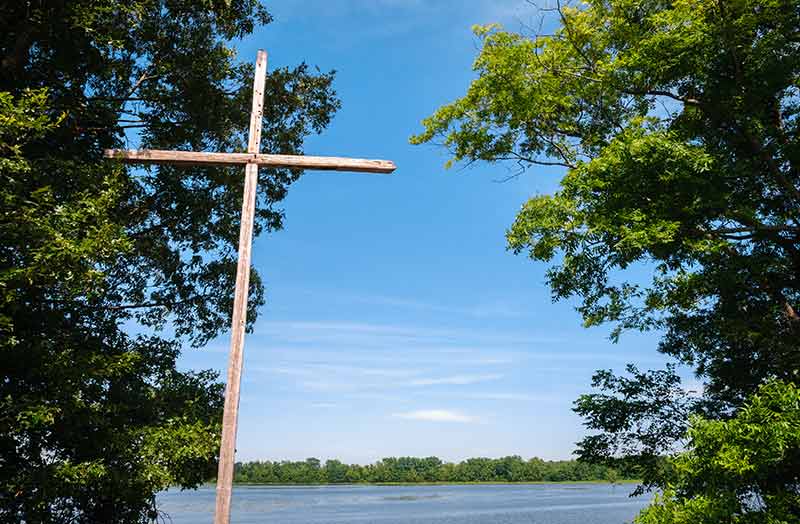
In southwest Arkansas near Gillett, around 80 miles (128 km) from Little Rock, there is the Arkansas Post National Memorial.
This memorial is actually a park and preserves a 17th-century French settlement that was the first permanent European settlement in the Mississippi River Valley.
The French founded the outpost in 1686.
Over the centuries, the outpost was occupied by the French, Spanish, the Confederacy and the United States.
At this site, you can see the ruins of the old town called Arkansas Post.
There is also an interpretive centre with various exhibits where you can learn more about the post’s heaviest battle, the 1864 Battle of Fort Hindman.
National River
2- Buffalo National River
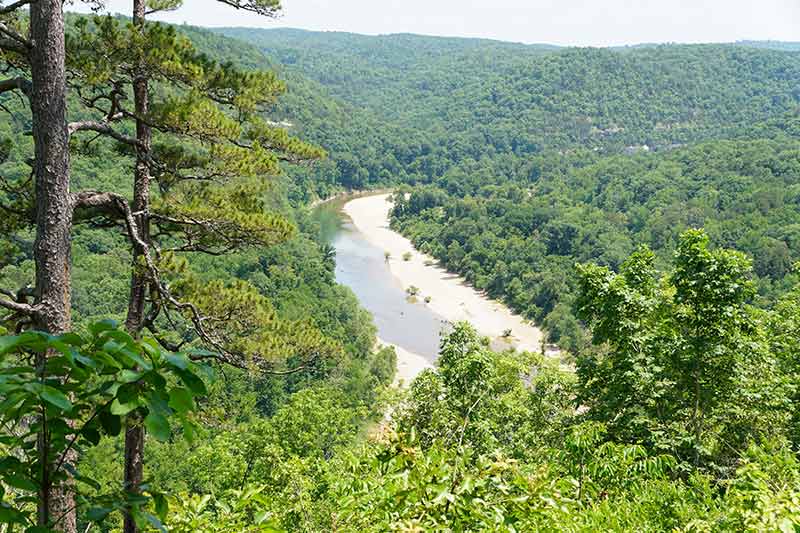
In 1972 the Buffalo River became the United States first designated national river.
The river winds its way around Ozark Mountain country and is super peaceful and beautiful.
This 152-mile-long river dates back hundreds of millions of years.
In the Paleozoic Era, sediment deposits formed the area’s rugged landscape and bedrock of the river.
Archaeological discoveries suggested that Native Americans lived along the Buffalo River from 9500 B.C.
Later, the Buffalo River Valley was divided in the Civil War; half was taken by the Union and the other, Confederate supporters.
Since becoming the first national river in the U.S., the Buffalo National River has become a popular spot for various outdoor activities.
Visit the river to enjoy camping, fishing, hiking and canoeing. You can choose to bring your own canoes or hire from the local rental shops.
National Historic Site
3- Little Rock Central High School National Historic Site

Little Rock Central High School played a fundamental role in the American Civil Rights Movement.
In 1957 nine African American teenagers stood up to a group of angry individuals while trying to enter an all-white high school.
As these teens entered the school for the very first time, they experienced a backlash of racial abuse and hate.
Governor Orval Faubus mobilised the Arkansas National Guard to prevent these nine students from entering the high school.
Bearing in mind the Brown v. Board of Education ruling was passed in 1954, this was a highly defiant move by Faubus.
As a result of his actions, President Dwight D. Eisenhower had to federalise the Arkansas National Guard, removing the guard from Faubus’ control.
Little Rock Central High School is a fully functioning school.
It’s the only operative school to be part of a national historic site in the U.S.
Right across from the school is the visitors centre, which allows you to understand more about the Civil Rights Movement and the events that unfolded at Little Rock Central High School in 1957.
4- Fort Smith National Historic Site
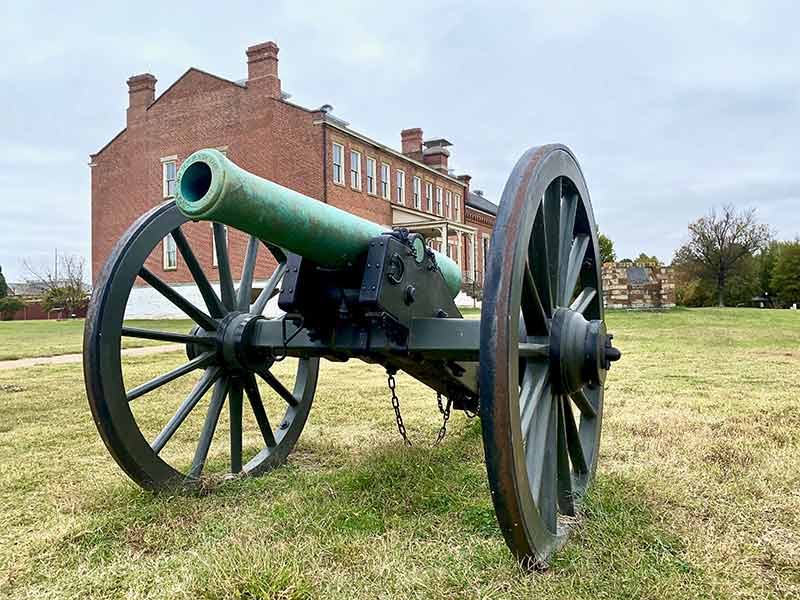
Another of Arkansas’ national historic sites is Fort Smith, which is in the town of Fort Smith in central west Arkansas and is perfect for history lovers.
This historic site will show you what life was like in the Old West.
There are two frontier forts, and it was the headquarters of the famous Hanging Judge.
It was at Fort Smith that U.S. District Judge Isaac C. Parker sentenced 70 people to the gallows following the turmoil of the Civil War.
Parker’s actions inspired top western movies like “Hang’ Em High” and “True Grit”.
At this historical site, you can see the ruins of the original fort, Parker’s notorious courtroom, and the jail nicknamed “Hell on the Border”.
5- President William Jefferson Clinton Birthplace Home National Historic Site
For a spot of Arkansas’ presidential history, head to the William Jefferson Clinton Birthplace in Hope, Arkansas.
The historic site is housed in a 1917 building where Bill Clinton, the 42nd President of the United States, spent the first four years of his term in office.
Visitors can tour the house and learn about the life and work of William J. Clinton.
You can visit alone or take a 25-minute guided tour of his birthplace. Starting at 9 am, tours of the house leave from the visitor centre every 45 minutes until 3.45 pm.
National Military Park
6- Pea Bridge National Military Park
The Pea Bridge National Military Park commemorates an important but forgotten Civil War battle.
It was in 1862 that more than 23,000 soldiers fought at Pea Bridge to decide what would happen to Missouri, arguably defined as the turning point of the Civil War in the west.
The Pea Bridge National Military Park is a battlefield that even history buffs may not be aware of.
Despite this, it was one of the most important Civil War battle sites west of the Mississippi River, and unlike other Civil War battlefields, this one remains relatively intact.
At the visitor centre, guests can watch a 30-minute film called “Thunder In the Ozarks”, which outlines the area’s history. There is also a museum that has several exhibits.
National Historic Trail
7- Trail of Tears National Historic Trail
The Trail of Tears National Historic Trail is 5,043 miles (8116 km) long and passes through the states of Alabama, Arkansas, Georgia, Illinois, Kentucky, Missouri, North Carolina, Oklahoma and Tennessee.
This trail represents the dark history imposed on Native Americans during the 1830s.
After the Indian Removal Act of 1830, those American Indians living in their tribal and ancestral homelands of the Deep South were unjustly forced to relocate west of the Mississippi River.
Not only did they have to move, but they were forced to forfeit their ancestral land to white settlers.
46,000 American Indians from the southeast had been removed from their land by 1837.
Of the Cherokee Nation, it is believed that between 3,000 and 4,000 of the 16,5000 Cherokee died on their passage to their new territory while walking the trail that is now called the Trail of Tears.
The Cherokee people had to walk vast distances, traverse rivers, suffering illness, starvation and harsh winters, which meant deaths occurred daily.
Around 100,000 indigenous people were forced from their homes during the 1830s.
Today the Trail of Tears evokes a sense of collective suffering.
To journey along this trail now offers a sense of appreciation for the hardships felt by so many Native Americans.
While the trail meanders through beautiful Arkansas landscapes, it’s the reflection of a historical abomination that will stay in your memory.
Though Arkansas’ section of the trail doesn’t have a visitor centre, across the border in Missouri, there is the Trail of Tears State Park, where you can learn about this horrific removal of Native American people from their land.
National Parks
8- Hot Springs National Park
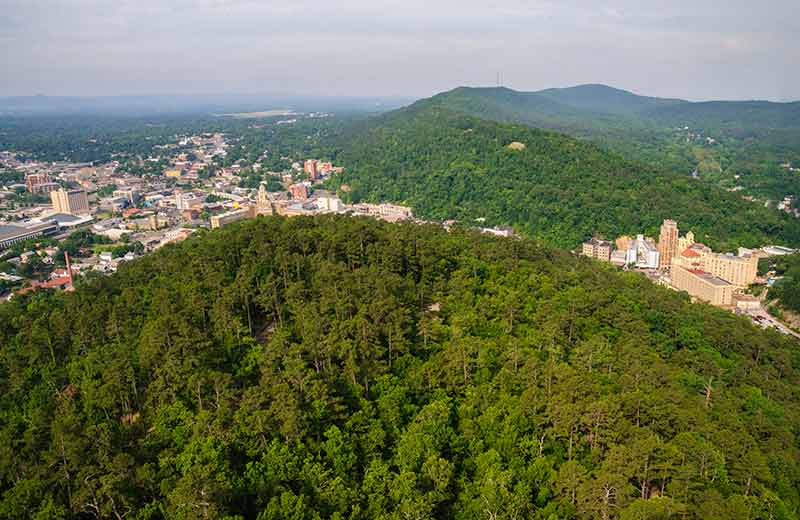
Hot Springs National Park is the state’s capital letter National Park and one of Arkansas’ biggest attractions.
Hot Springs National Park is in central west Arkansas, around 45 miles (72 km) from Little Rock.
This park is open year-round to enjoy the historic bathhouses and surrounding hiking trails.
You’ll find this National Park in Arkansas in the city of Hot Springs.
It was considered “America’s first resort” as it preserves the famous hot spring of Ouachita.
These hot springs are naturally heated, and the steam water flows from the mountain.
In 1832, the federal government designated the area’s 47 hot springs an area of preservation and recreation.
From this, the development of the city of Hot Springs unfolded, and it soon became the nation’s oldest spa town.
Originally the waters were enjoyed by Native Americans back when the area was known as the Valley of Vapors (it’s got a nice ring to it).
It wasn’t until the 19th century that Americans began to discover the healing and calming properties of the waters.
Today, Hot Springs National Park aims to preserve the history of the area and the natural landscape.
The crowning jewels of the park are the beautifully preserved Bathhouse Row bathhouses.
Fordyce Bathhouse is the most attractive and grand of all the bathhouses and is now the park’s visitor’s centre.
Here you can learn about the area’s history and natural landscape.
Head to the Lamar Bathhouse and you’ll find a brilliant artisan market and gift shop.
Then the Quapaw and Buckstaff Bathhouses are the two functioning bathhouses in Hot Springs.
Pamper yourself at these bathhouses with massages, facials and a dip in the hot springs.
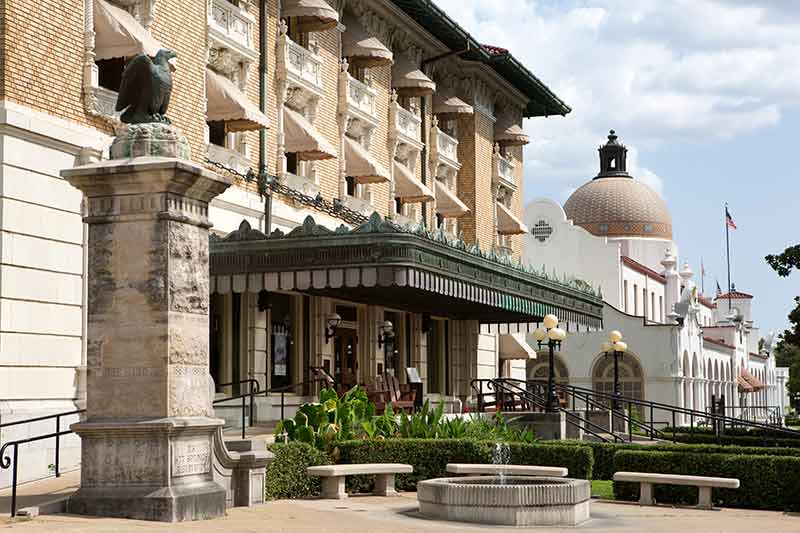
You can also go for a walk along the Grand Promenade. This area provides views of the bathhouses and surrounding landscape.
You can also head to the Hot Springs Mountain Tower, where you can enjoy spectacular views of the Hot Springs.
The Hot Springs National Park, known for its healing and soothing waters, was popular among notable celebrities of the day.
Al Capone, Herbert Hoover, John F. Kennedy, Babe Ruth, and Jesse James were just a few people who frequented the hot spring bathhouses.
Another destination to put on your Hot Springs bucket list is the Gangster Museum, dedicated to Mafia members who spent time in Hot Springs.
Some of those notorious members included Frank Costello and Lucky Luciano. Unfortunately for Luciano, he wasn’t so lucky when he visited Hot Springs as the police arrested him!
As well as the hot springs themselves, you can go hiking in this beautiful park.
The trails in the Hot Springs National Park are wide-ranging and there’s something for all abilities.
From 0.5-mile trails to 18-mile ones, there are plenty of places and pathways to explore.
The Peak Trail to Hot Springs Mountain Loop is one of the park’s best trails.
This trail is 2.9 miles and starts from Bathhouse Row.
The trail leads you up to Hot Springs Mountain and continues in a loop around the top before returning to where you started.
Another excellent hike is Goat Rock Trail, a moderate trail of 1.1 miles that offers amazing views of the Ouachita Mountains.
This is also the source of the additional water that’s used for the springs.
The Sunset Trail is another great hike with various vistas to enjoy along the way, passing by a pond, fields of wildflowers and up to the park’s highest point.
Of course, you can end your hike by watching a beautiful sunset before heading back.
While walking these trails, look for bird life like eagles, hawks, woodpeckers, wrens and cardinals, so bring your binoculars.
Arkansas has many historically interesting and naturally beautiful national parks to explore.
Though the biggest attraction is the Hot Springs National Park learning about Arkansas through some of the other national park service sites is an excellent way to explore the state.
If you love exploring national parks, you might like to read:
- Wyoming National Parks Guide
- Nevada National Parks Guide
- Michigan National Parks Guide
- 5 Maine National Parks
- New Hampshire National Parks Guide
- 25 National Parks in Canada
- 17 National Parks in Argentina
- Tasmania National Parks
- 20 National Parks in Mexico
- 18 New Mexico National Parks
- 18 National Parks in Massachusetts
- 17 Colorado National Parks
- 4 Indiana National Parks
- 5 Nebraska National Parks
- 30 Virginia National Parks
- 9 New Jersey National Parks
- 8 National Parks in Arkansas
- 8 Alaska National Parks
- 13 Tennessee National Parks
- 6 National Parks in Louisiana
- 5 Illinois National Parks
- 7 National Parks in Oklahoma
- 7 National Parks in South Dakota
- 12 Alabama National Parks
- 5 North Dakota National Parks
- 8 National Parks in West Virginia
- 20 National Parks in Arizona
- 11 National Parks In Florida
- 8 Hawaii National Parks
- 6 National Parks In Idaho
- Texas National Parks Guide
- 9 California National Parks
- 11 National Parks In Georgia
- 7 National Parks In Missouri
- 5 National Parks in Minnesota
- 7 National Parks In Kentucky
- 8 National Parks In Montana
- 15 National Parks In Washington State
- 8 South Carolina National Parks
- 12 North Carolina National Parks
- 4 Wisconsin National Parks
- 20 National Parks In India
- 11 Oregon National Parks
- 5 Connecticut National Parks
- 27 National Parks In New York State
- 4 Iowa National Parks
- Yosemite National Park
- Zion National Park
- 21 National Parks in Pennsylvania
- 9 National Parks in Mississippi
- 5 National Parks in Rhode Island
- 9 National Parks in Taiwan
- 20 East Coast National Parks
- Guide To Winter in Yellowstone National Park
Plan Your Trip

Rent A Car – Find the best car rental rates at Discover Cars. They compare car hire companies to provide you with the best deal right now.

Find A Hotel – If you’re curious about this article and are looking for somewhere to stay, take a look at these amazing hotels.

